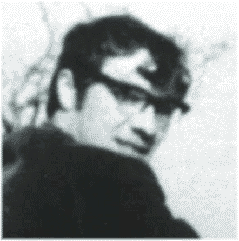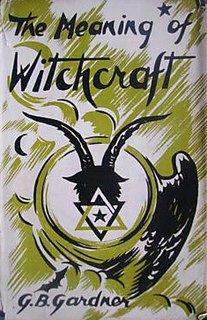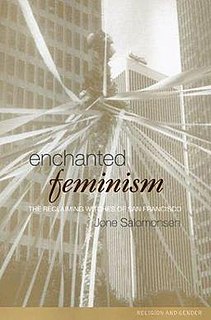Related Research Articles

Gardnerian Wicca, or Gardnerian witchcraft, is a tradition in the neopagan religion of Wicca, whose members can trace initiatory descent from Gerald Gardner. The tradition is itself named after Gardner (1884–1964), a British civil servant and amateur scholar of magic. The term "Gardnerian" was probably coined by the founder of Cochranian Witchcraft, Robert Cochrane in the 1950s or 60s, who himself left that tradition to found his own.

The Horned God is one of the two primary deities found in Wicca and some related forms of Neopaganism. The term Horned God itself predates Wicca, and is an early 20th-century syncretic term for a horned or antlered anthropomorphic god partly based on historical horned deities.

Skyclad refers to ritual nudity in Wicca and Modern Paganism. Some groups, or Traditions, perform most or all of their rituals skyclad. Whilst nudity and the practice of witchcraft have long been associated in the visual arts, this contemporary ritual nudity is typically attributed to either the influence of Gerald Gardner or to a passage from Charles Godfrey Leland's 1899 book Aradia, or the Gospel of the Witches, and as such is mainly attributed to the Gardnerian and Aradian covens.

Wicca is a modern Pagan religion. Scholars of religion categorise it as both a new religious movement and as part of the occultist stream of Western esotericism. It was developed in England during the first half of the 20th century and was introduced to the public in 1954 by Gerald Gardner, a retired British civil servant. Wicca draws upon a diverse set of ancient pagan and 20th-century hermetic motifs for its theological structure and ritual practices.

An athame or athamé is a ceremonial blade, generally with a black handle. It is the main ritual implement or magical tool among several used in ceremonial magic traditions, and by other neopagans, witchcraft, as well as satanic traditions. A black-handled knife called an arthame appears in certain versions of the Key of Solomon, a grimoire dating to the Renaissance.

A Book of Shadows is a book containing religious text and instructions for magical rituals found within the Neopagan religion of Wicca. Since its conception in the 1970s, it has made its way into many pagan practices and paths. The most famous Book of Shadows was created by the pioneering Wiccan Gerald Gardner sometime in the late 1940s or early 1950s, and which he utilised first in his Bricket Wood coven and then in other covens which he founded in following decades. The Book of Shadows is also used by other Wiccan traditions, such as Alexandrian Wicca and Mohsianism, and with the rise of books teaching people how to begin following non-initiatory Wicca in the 1970s onward, the idea of the Book of Shadows was then further propagated amongst solitary practitioners unconnected to earlier, initiatory traditions.
The Feri Tradition is an initiatory tradition of modern Pagan witchcraft. It was founded in California in the 1960s by the Americans Victor Henry Anderson and his wife Cora Anderson.
Stregheria is the root form of Witchcraft originating in Southern Europe, but also includes Italian American witchcraft. Stregheria is sometimes referred to as La Vecchia Religione. The word stregheria is an archaic Italian word for "witchcraft", the most used and modern Italian word being stregoneria. "Stregoneria Italiana" is a form of stregoneria that took hold of southern Europe before the Catholic church forced practitioners to conform. Stregheria is rooted in folk magic having little if any relationship to other forms of Witchcraft.
Celtic Wicca is a modern tradition of Wicca that incorporates some elements of Celtic mythology. It employs the same basic theology, rituals and beliefs as most other forms of Wicca. Celtic Wiccans use the names of Celtic deities, mythological figures, and seasonal festivals within a Wiccan ritual structure and belief system, rather than a traditional or historically Celtic one.

The New Forest coven were an alleged group of witches who met around the area of the New Forest in southern England during the early 20th century. According to his own claims, in September 1939, a British occultist named Gerald Gardner was initiated into the coven and subsequently used its beliefs and practices as a basis from which he formed the tradition of Gardnerian Wicca. Gardner described some of his experiences with the coven in his published books Witchcraft Today (1954) and The Meaning of Witchcraft (1959) although on the whole revealed little about it, saying he was respecting the privacy of its members. Meanwhile, another occultist, Louis Wilkinson, corroborated Gardner's claims by revealing in an interview with the writer Francis X. King that he too had encountered the coven and expanded on some of the information that Gardner had provided about them. According to Gardner, the faith which they followed was the continuation of the Witch-Cult, a pre-Christian religion that originated in the paganism of ancient Western Europe. This was in keeping with the widely held theories then propagated by the anthropologist Margaret Murray and her supporters.

Philip Heselton is a retired British Conservation Officer, a Wiccan initiate, and a writer on the subjects of Wicca, Paganism and Earth mysteries. He is best known for two books, Wiccan Roots: Gerald Gardner and the Modern Witchcraft Revival and Gerald Gardner and the Cauldron of Inspiration, which gather historical evidence surrounding the New Forest coven and the origins of Gardnerian Wicca.

Robert Cochrane, who was born as Roy Bowers, was an English occultist who founded the tradition of Witchcraft known as The Clan of Tubal Cain.
The history of Wicca documents the rise of the Neopagan religion of Wicca and related witchcraft-based Neopagan religions. Wicca originated in the early twentieth century, when it developed amongst secretive covens in England who were basing their religious beliefs and practices upon what they read of the historical Witch-Cult in the works of such writers as Margaret Murray. It was subsequently popularized in the 1950s by a number of figures, in particular Gerald Gardner, who claimed to have been initiated into the Craft – as Wicca is often known – by the New Forest coven in 1939. Gardner's form of Wicca, the Gardnerian tradition, was spread by both him and his followers like the High Priestesses Doreen Valiente, Patricia Crowther and Eleanor Bone into other parts of the British Isles, and also into other, predominantly English-speaking, countries across the world. In the 1960s, new figures arose in Britain who popularized their own forms of the religion, including Robert Cochrane, Sybil Leek and Alex Sanders, and organizations began to be formed to propagate it, such as the Witchcraft Research Association. It was during this decade that the faith was transported to the United States, where it was further adapted into new traditions such as Feri, 1734 and Dianic Wicca in the ensuing decades, and where organizations such as the Covenant of the Goddess were formed.

Wiccan views of divinity are generally theistic, and revolve around a Goddess and a Horned God, thereby being generally dualistic. In traditional Wicca, as expressed in the writings of Gerald Gardner and Doreen Valiente, the emphasis is on the theme of divine gender polarity, and the God and Goddess are regarded as equal and opposite divine cosmic forces. In some newer forms of Wicca, such as feminist or Dianic Wicca, the Goddess is given primacy or even exclusivity. In some forms of traditional witchcraft that share a similar duotheistic theology, the Horned God is given precedence over the Goddess.

In the neopagan religion of Wicca a range of magical tools are used in ritual practice. Each of these tools has different uses and associations and are commonly used at an altar, inside a magic circle.

The Meaning of Witchcraft is a non-fiction book written by Gerald Gardner. Gardner, known to many in the modern sense as the "Father of Wicca", based the book around his experiences with the religion of Wicca and the New Forest Coven. It was first published in 1959, only after the British Parliament repealed the Witchcraft Act of 1735, and proved to be Gardner's final book. The Wicca religion as expounded by Gardner was focused on a goddess, identified with the night sky and with wild nature, and a horned god who represented the fertilizing powers of the natural world. It was organized into covens, through which members were initiated through three ascending degrees of competence and authority and which were governed by a high priestess, supported by a high priest. More historical context to the pagan practice of Wicca can be found in the book Wicca: History, Belief, and Community in Modern Pagan Witchcraft That book discusses Wiccan life, covering how and why people convert to Wicca; its denominations; its sociological demographics; its political beliefs, particularly in terms of environmentalist issues; the impact of anti-Wiccan persecution; the transmission of Wiccan and Pagan culture; and the history of academic analysis of Wicca.
The Witchcraft Research Association was a British organisation formed in 1964 in an attempt to unite and study the various claims that had emerged of surviving remnants of the so-called Witch-Cult, such as those of Gerald Gardner, Robert Cochrane, Sybil Leek, Charles Cardell and Raymond Howard.
Traditional witchcraft or traditional craft are terms used by certain esoteric traditions who regard their practices as forms of witchcraft. The unifying feature of these groups is the attempt to differentiate themselves from the modern Pagan new religious movement of Wicca, whose followers typically call themselves witches, by emphasising "traditional" roots. Among traditions that have repeatedly been termed "traditional witchcraft" are Victor Henry Anderson's Feri Tradition, Robert Cochrane's Cochrane's Craft and Andrew D. Chumbley's Sabbatic Craft.
In Modern English, the term Wicca refers to Wicca, the religion of contemporary Pagan Witchcraft. It is used within the Pagan community under competing definitions. One refers to the entirety of the Pagan Witchcraft movement, while the other refers explicitly to traditions included in what is now called British Traditional Wicca.

Enchanted Feminism: The Reclaiming Witches of San Francisco is an anthropological study of the Reclaiming Wiccan community of San Francisco. It was written by the Scandinavian theologian Jone Salomonsen of the California State University, Northridge and first published in 2002 by the Routledge.
References
- ↑ Wiktionary:Witch
- ↑ Gerald Gardner, Witchcraft Today, ISBN 0-8065-2593-2
- ↑ Gerald Gardner, The Meaning of Witchcraft, ISBN 1-57863-309-5
